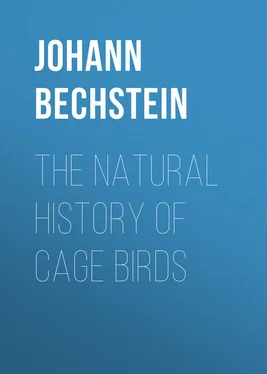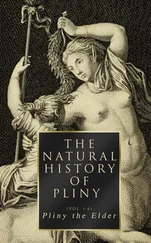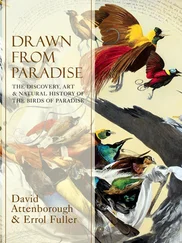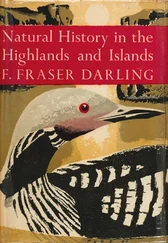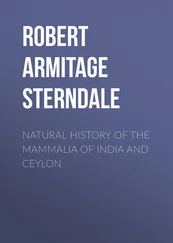Johann Bechstein - The Natural History of Cage Birds
Здесь есть возможность читать онлайн «Johann Bechstein - The Natural History of Cage Birds» — ознакомительный отрывок электронной книги совершенно бесплатно, а после прочтения отрывка купить полную версию. В некоторых случаях можно слушать аудио, скачать через торрент в формате fb2 и присутствует краткое содержание. ISBN: , Жанр: foreign_antique, foreign_prose, на английском языке. Описание произведения, (предисловие) а так же отзывы посетителей доступны на портале библиотеки ЛибКат.
- Название:The Natural History of Cage Birds
- Автор:
- Жанр:
- Год:неизвестен
- ISBN:http://www.gutenberg.org/ebooks/40055
- Рейтинг книги:4 / 5. Голосов: 1
-
Избранное:Добавить в избранное
- Отзывы:
-
Ваша оценка:
- 80
- 1
- 2
- 3
- 4
- 5
The Natural History of Cage Birds: краткое содержание, описание и аннотация
Предлагаем к чтению аннотацию, описание, краткое содержание или предисловие (зависит от того, что написал сам автор книги «The Natural History of Cage Birds»). Если вы не нашли необходимую информацию о книге — напишите в комментариях, мы постараемся отыскать её.
The Natural History of Cage Birds — читать онлайн ознакомительный отрывок
Ниже представлен текст книги, разбитый по страницам. Система сохранения места последней прочитанной страницы, позволяет с удобством читать онлайн бесплатно книгу «The Natural History of Cage Birds», без необходимости каждый раз заново искать на чём Вы остановились. Поставьте закладку, и сможете в любой момент перейти на страницу, на которой закончили чтение.
Интервал:
Закладка:
The sorts, which feed on insects when wild, should have some of these preserved for them through the winter, except where they can be procured at all seasons. At a baker’s shop, for instance, there are always plenty of meal-worms, crickets, and cockroaches, of which most of these birds are very fond: when those are not to be procured, a good substitute is the large white grubs that produce the cockchafers, which in some years are very plentiful, and may be kept in pots of turfy earth through the winter, as may also the maggots of the bluebottle fly, if procured late in the autumn; and they may be generally had as late as December. A quantity of these, kept in a pot of turfy earth in a cellar, or any other cool place, where they may not turn into flies too soon, is, I think, one of the best sorts of insects, and easiest kept and procured, for such birds through the winter. They will not touch them until they are well cleaned in the mould, but are then very fond of them, and a few every day keeps them in excellent health, and provokes them to sing.
Hon. and Rev. W. Herbert’s food for soft-billed birds. – Milk, which Mr. Sweet recommends, I have found very fatal to many of the soft-billed birds, and I never give it; but the blackcaps do not seem to suffer from it. They are very fond of a boiled carrot mashed and moistened, or beet-root boiled and mashed. A boiled carrot will keep fresh many days, in a basin of cold water, and is an excellent substitute for fruit in feeding them. Boiled cabbage, cauliflower, green peas are good for them; all sorts of puddings; a very little roast meat minced, I give them every day, and a little yolk of egg when it suits, but it is not necessary. The standard food is hemp-seed ground in a coffee-mill, and bread crumbs scalded and mashed up together, and fresh every day. They are very fond of ripe pears and elderberries (but elderberries stain the cage very much), currants, cherries, honeysuckle, and privet-berries.
Professor Rennie says, “I have more than once given the blackcap and other birds a little milk by way of medicine when they appeared drooping or sickly, and with manifest advantage 10 10 White’s Selborne, 8vo. edit. 1833.
.”
BREEDING OF TAME BIRDS
House birds, being most of them reared like canaries, can only be made pair with great difficulty. When this object is accomplished, all of them require a large quiet place, a whole room if it can be had, in which branches of pine should be put, – a place, in fact, as much as possible resembling their natural abodes. But should you succeed in this respect, as you can never procure the materials which form the general base of their nests, it is better to give them artificial ones, made of the bark of the osier, straw, or even turnings of wood, in which it is only to put the soft stuff for lining, such as wool, the ravelings of silk, linen, or cotton, and the birds will take possession of it.
It is of consequence that the food for paired birds, and for the different ages of their young ones, should be chosen with judgment. I shall mention what must be done in this respect, in the articles relating to the different species of birds which I am going to describe in this work.
I must not omit two interesting observations which were communicated to me by a lady of my acquaintance. It sometimes happens, during a dry season, that the young birds are not hatched on the proper day, or are in danger of not being hatched at all; if, in this case they are plunged for one minute in water about their own warmth, and then replaced under the bird, the effect will be as quick as it is successful 11 11 See Rennie’s “Habits of Birds,” p. 13. – Transl.
.
For the same reason, sometimes the young birds remain without their feathers beyond the proper time; a tepid bath removes with such success the dryness of their quills, that in twenty-four hours after replacing them damp in their nest they are in general covered with feathers. I shall end this paragraph with showing at what time it is best to remove young wild birds from their nest when intended to be reared. It is when the quills of the tail feathers are come out, and the other feathers are begun to grow, the eyes not being quite open. If removed earlier, their stomach will be too weak to support their new food; if taken later, it will be very difficult to make them open their beaks to receive a food which is unknown to them. There are some species, however, that are so easily reared, that any time will answer.
DISORDERS OF TAME BIRDS
All tame animals are much more subject to disease than wild ones; and birds so much the more, as they are often shut up in very small cages, where they can take no exercise. It is often supposed that birds, in their natural free state, have no diseases; but people who will take the trouble to observe, will soon perceive the falsehood of this assertion. I have often found hedge-sparrows full of pimples, particularly in the naked parts, the feet, and round the beak. Their diseases are often increased by the delicacies of all kinds which are given them, such as biscuits and sugar, which injure the stomach, and cause a slow decay.
The principal diseases and their cures, according to my experience, are as follows; not, however, that different birds do not require, according to their food, different treatment.
I shall mention, under each bird, what must be done to cure those diseases which are peculiar to it, when general remedies fail.
This is a catarrh, or cold, by which the nostrils are stopped up, and the membrane covering the tongue is hardened by inflammation. In large birds it is common to remove this skin, taking it off from the base to the tip: by this means this part can again perspire, the saliva necessary for digestion can flow, and the taste and appetite returns. A mixture of fresh butter, pepper, and garlic, generally cures this catarrh. It is a good thing, also, for the birds to drink the pectoral infusion of speedwell; and the nostrils may be opened by passing up a small feather. The ruffling of the head, the beak often open and yellow at its base, and the tongue dry, are the most decisive indications of this disease.
The symptoms of this disease are frequent sneezing and shaking of the head. Some drops of pectoral elixir in the infusion of speedwell, which the sick birds must be made to take, appears to me to be the most efficacious remedy. I have given fowls even twenty drops of the elixir in a glass of the infusion.
When it is merely hoarseness, Dr. Handel, of Mayence, gave to his birds for several days, as their only drink, a very diluted decoction of dry figs, sweetened with a little sugar, and afterwards purged them for two days following, with the juice of carrots.
This is a very common disease among house birds. Those attacked with it have their breath short, often open their beaks as if to gasp for more air, and, when agitated or frightened, keep them open for a long time.
The cause of this disease may doubtless be found in the mode of life which these birds lead. Their food is generally too dry and heating, being principally hemp-seed, which is very injurious, but liked by all; and is the more hurtful, as it inclines them to eat too much. If to this be added the unchanged air of the rooms, particularly those which have stoves instead of chimneys, and the great heat which is kept up during winter, it is plain that there is much to injure the delicate lungs of these birds.
A moist and refreshing regimen and some aperients, more or less often, according to the violence of the disease, appears the most appropriate remedy. A favourite linnet and goldfinch, when attacked with very bad asthma, were relieved and preserved for several years by the following method.
Читать дальшеИнтервал:
Закладка:
Похожие книги на «The Natural History of Cage Birds»
Представляем Вашему вниманию похожие книги на «The Natural History of Cage Birds» списком для выбора. Мы отобрали схожую по названию и смыслу литературу в надежде предоставить читателям больше вариантов отыскать новые, интересные, ещё непрочитанные произведения.
Обсуждение, отзывы о книге «The Natural History of Cage Birds» и просто собственные мнения читателей. Оставьте ваши комментарии, напишите, что Вы думаете о произведении, его смысле или главных героях. Укажите что конкретно понравилось, а что нет, и почему Вы так считаете.
